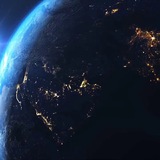This media is not supported in your browser
VIEW IN TELEGRAM
A simple comparison of the inner planets of the solar system
👍5💘3👏1
This media is not supported in your browser
VIEW IN TELEGRAM
Saturn carrying its own little version of the solar system
👍7🥰5❤3🤩2😎2
A giant catapult is being developed in California to hurl satellites into space without using fuel.
Inside the structure, satellites will be spun up to speeds of 8,000 kilometres per hour and then simply thrown into low orbit. It's estimated they'll fly six times faster than the speed of sound. The company has already conducted a bunch of successful tests and has started building a full-fledged catapult
Inside the structure, satellites will be spun up to speeds of 8,000 kilometres per hour and then simply thrown into low orbit. It's estimated they'll fly six times faster than the speed of sound. The company has already conducted a bunch of successful tests and has started building a full-fledged catapult
😁7🔥6🤡3👍2
This media is not supported in your browser
VIEW IN TELEGRAM
The Sun not setting over the Earth's limb🌅
You know that in one day astronauts on board the ISS can observe up to 16 sunrises and sunsets.
But at times when the station's orbit passes near the terminator (the line separating the illuminated and unilluminated sides of the planet), the Sun may not set at all for its inhabitants.
The ISS is not always near the terminator, as this line shifts throughout the year due to the tilt of the Earth's axis of rotation.
You know that in one day astronauts on board the ISS can observe up to 16 sunrises and sunsets.
But at times when the station's orbit passes near the terminator (the line separating the illuminated and unilluminated sides of the planet), the Sun may not set at all for its inhabitants.
The ISS is not always near the terminator, as this line shifts throughout the year due to the tilt of the Earth's axis of rotation.
👍7🤔4🤡2🔥1
This media is not supported in your browser
VIEW IN TELEGRAM
Curiosity has filmed the night sky over Mars!
👍15🤔5😱4🤡3
This media is not supported in your browser
VIEW IN TELEGRAM
🌅 NASA's InSight lander has recorded a sunset on Mars in 2022.
👍6
This media is not supported in your browser
VIEW IN TELEGRAM
Astronaut Christopher Cassidy works outside the space station.
And some numbers that will help you look at this video in a different way: the station is currently moving relative to the Earth's surface at a speed of 28,000 km/h (8 times faster than a bullet), and the station weighs 418 tons.
And some numbers that will help you look at this video in a different way: the station is currently moving relative to the Earth's surface at a speed of 28,000 km/h (8 times faster than a bullet), and the station weighs 418 tons.
👍5🤡5🔥3🤔1
Mercury, Venus, Mars, Earth — what elements make up the atmosphere of the eight planets of the Solar System. Let's take a look today. On the chart from COMPOUND INTEREST 2014.
Mercury is predominantly composed of O2 (oxygen), which is 42% of the total mass of gases on the planet. Venus and Mars are made up of 96% and 95% CO2 (carbon dioxide), respectively. The atmospheres of the four gas giants, such as Jupiter, Saturn, Uranus, and Neptune, are almost completely filled with hydrogen.
Mercury is predominantly composed of O2 (oxygen), which is 42% of the total mass of gases on the planet. Venus and Mars are made up of 96% and 95% CO2 (carbon dioxide), respectively. The atmospheres of the four gas giants, such as Jupiter, Saturn, Uranus, and Neptune, are almost completely filled with hydrogen.
👍3🔥2💯2🤣2🍌1
This media is not supported in your browser
VIEW IN TELEGRAM
☀️ Demonstration of the speed at which the planets of the Solar System rotate around the Sun.
🔥9👍5🤣5❤2😱1👌1🤡1🤨1🆒1
This media is not supported in your browser
VIEW IN TELEGRAM
🌏 This is how the appearance of our planet has changed over the course of 200 million years.
Over the past 200 million years, the appearance of the Earth has undergone impressive changes.
The period includes changes in landforms, mountains, oceans, the evolution of plants and animals, and in particular the split of the supercontinent Pangea into 6 others, smaller and more widely known in the modern world — Eurasia, Asia, Africa, North and South America, and Antarctica.
Over the past 200 million years, the appearance of the Earth has undergone impressive changes.
The period includes changes in landforms, mountains, oceans, the evolution of plants and animals, and in particular the split of the supercontinent Pangea into 6 others, smaller and more widely known in the modern world — Eurasia, Asia, Africa, North and South America, and Antarctica.
🤣8👍4🤯3😁2❤1🍌1
This media is not supported in your browser
VIEW IN TELEGRAM
We have all seen the behaviour of astronauts in weightlessness. But few of us have seen the behaviour of four-legged friends, such as cats, who have been placed in a training room for testing.
It looks like fun! 😸
It looks like fun! 😸
🤣8👎7🤮4👍2🤬2😁1🍌1
